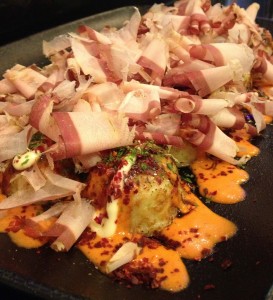Ikemen impresses with big, bold flavors
In a city that becomes awash in a flurry of scarves and pea coats at the first sight of 60-degree weather, a hot bowl of traditional Japanese ramen can serve as a culinary refuge for many during Los Angeles’ infamously “harsh” winters. However, tsukemen, which is ramen suited for warmer weather, challenges Southern Californian notions of what the noodle dish ought to be.

Good eats · At Ikemen, each ingredient is carefully selected. The sauce added to Red Dragon gives the soft doughy octopus takoyaki a nice heat. – Euno Lee | Daily Trojan
Though traditional ramen combines a savory broth with noodles to create a rich, hot dish, tsukemen, or “dip ramen,” separates the two elements and cools them down.
When Ikemen first opened its doors in Hollywood in 2011, the reaction to its tsukemen, or “dip ramen,” was hit-or-miss with Californians in the throes of a ramen revolution. But, now that ramen has transcended trendiness to flesh out its own niche in Los Angeles’ dining scene, revisiting ramen’s more chilled-out cousin seems warranted. The recent opening of another branch of Ikemen at the Weller Court in Little Tokyo gives us a closer look into what might quickly become one of Los Angeles’ late-night culinary traditions.
The recipes and menu at Ikemen are the brainchild of famed Japanese chef Shigetoshi “Sean” Nakamura. Japan, a country which has no qualms about defying its culinary figureheads, identifies Nakamura as one of the Four Ramen Devas, or one of Japan’s four gods of ramen. These select chefs enjoy national prominence on account of their perceived mastery of the preparation of ramen in their respective regions.
Nakamura’s culinary genius is aptly substantiated through Ikemen’s ambitions, and Ikemen’s menu reads like a creative exercise on the Japanese-born flavor phenomenon of umami (Umami is best described as a deep, savory taste which also doubles as the Japanese word for “delicious”).
One of the most interesting ways Nakamura introduces the element of umami to his menu includes the katsuobushi, or dried bonito flakes. Though high quality pre-shaved katsuobushi can be found packaged at Japanese markets, Nakamura takes things a step further: Ikemen imports their dried bonito in the form of whole dried fish flown directly from Japan. The fish, which have been smoked and dried repeatedly over the course of up to two weeks, come to resemble hunks of charred oak wood. Right before serving, these hunks are put into on-site shaving machines designed specifically for creating parchment-thin swatches of gorgeously striated katsuobushi.
The katsuobushi makes its most welcome appearance in the Ikemen Dip ramen, where the thin slivers melt into the porky broth (dubbed Tonkotsu Au Jus) and lend it a positively surreal amount of umami. The thick noodles used to soak up the broth are no afterthought, either: Wavy, pale-gold and perfectly al dente, the noodles are practically bespoke for dipping and in an altogether different league from the likes of Daikokuya or Shin-Sen-Gumi.
Ikemen attempts to tackle umami from a different angle in the Ghost Buster Dip. Here, the aforementioned Tonkotsu Au Jus is treated with cream, truffle oil and sauteed mushrooms. The finishing touch is a marshmallow, which is set ablaze tableside by a waiter wielding a handheld blowtorch. The hapless marshmallow is then dunked in the broth to meld with the surrounding flavors, which it does marvelously.
A sampling of the broth reveals a procession of flavors beginning with the porky au jus, followed by the earthy umami of the truffle oil and mushrooms, rounded out with the slight sweetness of caramelized marshmallow. The finish melds all of the flavors and lingers pleasantly, familiarizing what is an eclectic, yet oddly comforting, dish.
Ikemen falters in one area of admittedly limited importance: the chashu, or pork, is prepared in the kitchen by applying heat from a handheld blowtorch. Though the preparation does allow for a fully cooked product with a cool temperature suitable for summertime tsukemen, the flavor of the pork itself is a little underwhelming and compares unfavorably to the pork offered at Santouka or Ramen Yamadaya.
Much like the menu’s emphasis on a departure from traditional ramen shop offerings, the storefront and waitstaff at Ikemen’s Little Tokyo location are a change from the staunch traditionalism and outwardly Japanese design elements often typified in the decor of authenticity-obsessed Southern California ramen restaurants.
Instead, the Little Tokyo location playfully juxtaposes sleek, minimalist black countertops with comically ornate tall-backed wooden thrones. The piano solo from Horace Silver’s “Song for My Father” clangs through the restaurant’s speaker system, and the staff are dressed with a matching ivory-tickling whimsy: Everyone from the kitchen to the front is outfitted in neckties and fedoras to augment the overall slick-yet-playful aesthetic of the location.
Those accustomed to traditional hot ramen will certainly enjoy Ikemen’s Premium Ramen, but to do so would be to miss the point of the restaurant, at least partially. Ikemen’s Little Tokyo specifically highlights their tsukemen and breaks from preconceived notions of Japanese ramen in every sense. It’s unfortunate that Ikemen’s opening coincided with winter in Southern California, as its tsukemen is best suited for the warmer weather the city enjoys for eight months out of the year. Ikemen’s strong execution in the kitchen and ambitious flavor profiles, however, are sure to win over followers regardless of the season.
Ikemen’s Little Tokyo location is located inside the Weller Court Shopping Center on the south corner of 1st and Los Angeles streets, adjacent to the Marukai Market. Cash only.
